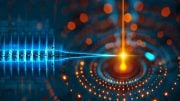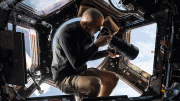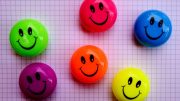
An early prototype of new LED fixtures (Solid State Lighting Module) that could help to prevent astronaut insomnia aboard the International Space Station. Credit: Kennedy Space Center
By investing $11.4 million to change out aging fluorescent lights in the International Space Station’s U.S. Orbital Segment, NASA hopes to prevent astronaut insomnia and to help space station crews sleep better aboard the International Space Station.
Sleep medication drugs are the second-most common drug taken by astronauts after painkillers, according to NASA. Astronauts are scheduled for 8.5 hours of sleep a day, but average six hours, and that’s with the help of pills, relaxation technique, and sleep education. If sleep deprivation is maintained over the course of several months, it starts to take its toll.
NASA has found no single reason why astronauts often go months without a good night’s sleep. It could be a combination of the sensation of floating in bed, constant noise, variable temperature, poor air circulation, nagging backaches and headaches, frequent shifts between Houston and Moscow time zones, and a new dawn every 90 minutes that confuses circadian rhythms.
Sleep deprivation is dangerous in orbit and NASA hopes to fix the disruption of normal circadian rhythms with new lamps. Research shows that our bodily clocks are wound by light exposure and about a decade ago, scientists discovered a new type of light-sensitive cell in our eyes. The retinal ganglion cells have no role in vision, but instead inform the suprachiasmatic nucleus in the brain what time it is. This in turn provides cues for thousands of schedule-sensitive bodily processes.
When these receptors are exposed to a wavelength of blue, humans feel more alert because the brain suppresses melatonin, a key hormone in sleep regulation. In contrast, red-spectrum light allows melatonin to flow without impedance.
The new lamps fit the exact footprint of their predecessors, and comprise a rainbow of more than 100 LED bulbs cloaked by a diffuser, so they appear as a single panel of white light. The fixtures have three modes, each with a subtly different hue: White light is for general vision, a cooler blue-shifted light promotes alertness, and a warmer red-shifted light triggers sleepiness. The LEDs are lighter, cooler, more durable, less toxic, and more energy-efficient.
The lamps are expected to be delivered by Boeing by 2015.









Be the first to comment on "LED Lights May Help Prevent Astronaut Insomnia Aboard the ISS"